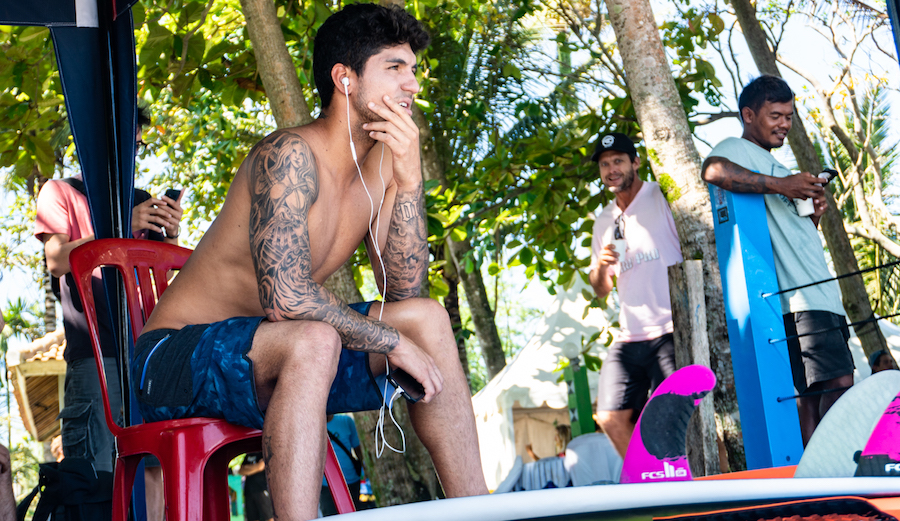
If a CT star can swoop in to any event and steal points they don’t need away from someone who might, is the system broken? Photo: Tim Hain/WSL
While the majority of the top-ranked surfers on the WSL Championship Tour are using the break between Bells and Bali to recover, Gabriel Medina is curiously donning a singlet.
With little fanfare, the Brazilian, currently ranked fifth on the CT, showed up to compete at the third annual Krui Pro on Sumatra – a QS3,000. He got second in his first four-man heat and will advance to round 4 and (likely) beyond. The question remains: why?
First and foremost, the site of the Krui Pro, Ujung Bocur, cranks. So, being able to surf it with only a few people out is a fairly desirable position to be in. The event’s proximity to the next CT stop at Keramas Beach in Bali, one could argue, is another potential explanation. “Gabs was in the neighborhood and figured why not?” you could say. Finally, losing out at Bells to event-winner John John Florence when you’re seeking to defend your second world title, and oh yeah, John’s got two, too, has to sting a little bit. Maybe taking it out on the lower ranks of the QS eases the pain, while also staying loose for the next stop? Who knows? Maybe it’s a little of all three.
To me, the more important reality that Medina’s little Sumatran pit stop raises is an inherent flaw in the way the World Surf League operates its Qualifying Series: that the Championship Tour’s highest ranked athletes are able to swoop in unannounced and effectively take valuable points they don’t need away from surfers grinding it out on the QS to make their CT dreams a reality.
Unlike most mainstream sports leagues stateside, across the pond the English Premier League operates a promotion and relegation system that parallels the WSL’s CT/QS relationship in important ways. In the U.S., if you’re a Baltimore Ravens fan, you can be sure they’ll remain in the NFL from year to year even if they finish last in the league. Not so with the Premier League. The system is painfully complicated, but the most important element is this: after each season, the three teams that finish at the bottom are relegated to the lower league, and the top three finishers of that lower league get promoted to the newly-created vacancies. It’s much like the way the WSL CT welcomes a new crop of rookies each year and relegates the year’s lowest performers back to the QS.
Imagine for a minute, though, if Manchester City – currently ranked first in the Premier League – were allowed to schedule a game against the Blackburn Rovers – who compete in the second highest tier league – to air frustrations after a tough loss against Arsenal. And on top of that, if Blackburn lost it’d count against them in league standings while the results would only impact Manchester City’s reputation. That’s tantamount to what’s happening here. If Gabriel Medina wins the Krui Pro, he’ll win valuable points he has no use for because he’s never been on the re-qualification bubble. And the runner-up will be left to eat dirt because they could’ve gotten first (and improved their qualification chances) if Medina hadn’t randomly thought: “That wave would be fun to surf with only a few guys out.”

Is Medina taking his frustrations out on a QS3,000 competitive field? Photo: Federico Vanno/WSL
To be clear, exploiting a strange idiosyncrasy of a system isn’t the fault of Medina, rather the entity that designed the system in the first place. The thinking is clear, to some degree. The reason the CT/QS relationship exists – that is that CT surfers can freely compete in QS events but not vice versa – is so that low CT performers can improve their chances of remaining on tour by also competing in QS events and rising to the top of those rankings. Point ratings are helpful, too. A QS1,000 is worth fewer points and so doesn’t attract the level of talent as say a more valuable QS10,000.
But a fairer system, as in the Premier League, would create impenetrable boundaries between the QS and CT. Maybe with fewer relegations as well since each year roughly one-third of the men’s and women’s tours respectively are on the chopping block – meaning a third of CT surfers have to pull double duty with QS and CT events all year.
QS events would certainly draw smaller crowds if they didn’t occasionally draw big names. Case in point: who was paying attention to the results of the Krui Pro before Medina showed up? But if the WSL hopes to service its athletes – especially the ones vying to compete on the CT – maybe it should reconsider its age-old policy. It just ain’t fair.
Editor’s note: The World Surf League did not immediately respond to request for comment on this story.

